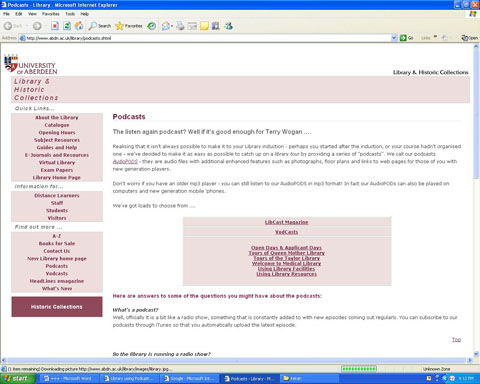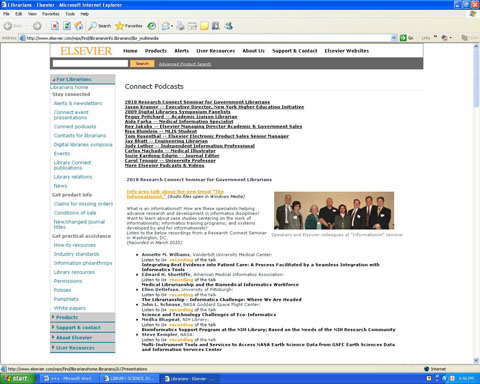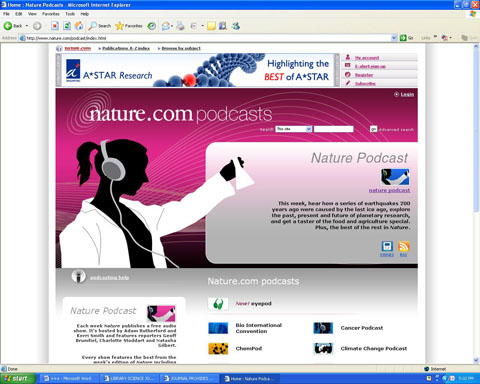Open Broadcasting Techniques for creating a Superhighway of Information Retrieval in the Modern Era
Mayank Trivedi and Vishnu Suthar
Abstract
The revolutionary innovations of Internet technologies have changed the ways in which people think, communicate and search information immediately. In this context, libraries have great challenges before them. Researchers often do not have sufficient time to conduct comprehensive online searches to locate the latest information relevant to their areas of specialty. Despite an increasing availability of online content and a continuing need to have the latest information easily accessible, a new method is needed to bring information to the user in an effective and efficient manner. This paper focuses on the benefits of using podcast technology in library and information science.
Introduction
Portable media devices have become common. For several years now, devices such as iPods, iRivers, and others can be seen attached to everyone from teens to library staff and users. What are people listening to or watching on these tiny devices? Most often, it is downloaded music, movies, or television programs. Interestingly, with the advent of portable media devices, other forms of downloadable media have also emerged. Two of these forms are podcasting and vodcasting. Podcasting is a form of media found on peer–to–peer file sharing, where users exchange files over the Internet by either uploading or downloading files from individual terminals. Specifically, podcasting is a distribution of audio files — and vodcasting is a distribution of video files — over the Internet using Rich Site Summary (RSS) or Atom Syndication Format, for listening or viewing on mobile devices and personal computers. Podcasts are Web feeds of audio or video files placed on the Internet for subscription and downloading. Unlike a simple download or real–time streaming, the subscription feature of automatically delivered new content is what distinguishes podcasts from other media [1]. Currently, some pod/Web casts are free to download and enjoy, while others are available for a fee. Musical podcasts have an intriguing mix of for–profit and free options.
One would think that free downloads are generally created by unknown artists. While at one time that may have been true, now that is no longer the case. Podcasting is a relatively new area for library services, and libraries are incorporating podcasting technology into their services by creating, editing, linking and disseminating their own and other podcasts. Podcasting offers new opportunities to deliver information more effectively and with ease of access anywhere and at any time someone wants to listen.
Meaning of Podcasting
The New Oxford American Dictionary defines a podcast as “a digital recording of a radio broadcast or similar program, made available on the Internet for downloading to a personal audio player.” [2] In other words, it’s a digital audio file that’s created, shared, and heard. Although many podcasts contain only music or only speaking, most are a creative mix of voice, music, and sounds. Some now include video or photos. There is a wide variety of content, such as National Public Radio programming, a university lecture, an international news update, a band’s newest music, or an individual’s enthusiastic view of a political issue. Podcasts range in length from a few minutes to several hours.
Audio material is created in a digital format and then published to the Web for subsequent downloading, usually in MP3 format. Typically, after the audio material has been downloaded, it is transferred to a portable device e.g., an MP3 player, on which it can be listened to anywhere and at any time. The process of transferring the material to a portable device is known as syncing, and some devices require specific software for this; for example, the Apple iPod series, which requires iTunes. Many generic devices behave like memory sticks when attached to a PC, so material can simply be copied to them just like any other type of data. The term podcasting is a contraction of iPod, the popular range of personal media players from Apple, and broadcasting. This creates a bit of a misnomer, suggesting that an Apple iPod is required to listen to a podcast. Most podcasts are in the common MP3 audio format that will play on any computer or media player. Thousands of podcasts are published regularly, forming a sort of massive free Internet broadcast network. The content of programs can be anything: comedy, education, politics, fiction, music, hobbies, and so on [3].
Review of Literature
Podcasting literature in the library field covers different topics like how to use podcasts in the library, podcast history, “Listen to Podcasts”, “Useful Tools for Podcasting”. Murley describes podcasts as important for law librarians, and discusses ways in which podcasting may be helpful to law librarians to deliver LIS services [4]. Durbridge identified audio’s educational advantages as its ability to influence cognition through clarity of instructions and emotional aspects of learning by conveying immediacy and a connection with the teacher [5]. Chinnery discusses bringing an authentic cultural experience to students learning foreign languages, but such studies are seldom evaluative [6]. Mahjouri and Purnell provide essential steps to create podcasts for a library [7].
Objectives of the Paper
The objective of this paper is to examine the use of podcasting, how library and user awareness has evolved regarding academic and special libraries, and the aims and concepts of how to create podcasts. It will review some outstanding library, database, and journal podcasting Web sites and discuss LIS factors.
Methodology
The available literature on the topic has been studied and reviewed to examine the concept of podcasts in the library. Most of the information on podcasts has been taken from various search engines, using terms related to podcasting, and information resources data taken from relevant Web sites. Some conceptual and textual information related to the present study were collected from both primary and secondary sources of information such as books, professional journals, magazines, newspapers, and conference proceedings, as well as from unpublished sources.
Utilization of podcasts in libraries
Libraries have embraced the Web as a conduit of information, but this is just one outlet through which students now seek information. To better meet our users “where they live,” libraries must continue to investigate new channels of information. Podcasting gives academic libraries a new means of reaching users on campus and off. Podcasts are unique in their capacity to be played on nearly any computer or portable media player, and RSS provides users with automatic updates whenever a new episode is published. Many libraries are exploring applications for podcasting such as broadcasting events, news, and information literacy instruction. Podcasting can help supplement face–to–face instruction, reach distance education students, ease library anxiety, and provide point–of–need instruction material for students with information needs [8].
Podcasts are platform–neutral: they are not tied to a computer and can be played on many different devices. MP3 audio, by far the most common format for podcasts, is nearly universally portable. Any computer running any operating system is capable of playing MP3 files, as is any personal media player (PMP) and most modern cell phones. This gives college students the choice to control where and how they access programming, allowing them “to devote time to learn ... whilst doing something else, adding value to what is otherwise ‘dead time’.” [9] This explains some of the popularity of podcasting as a format. Podcasting serves not only as a method of distributing events, but also serves as a basic digital archive. Library development offices can take advantage of a free global audience for prominent events such as author appearances.
Academic libraries have begun to discover the potential for podcasts as a channel for promoting services, events, book reviews, and collections, but perhaps the most intriguing use is as a tool for information literacy instruction [10]. Many libraries produce podcasts as an outreach method for distance education students, who are often unaware of available library services and unable to take instruction classes. However, use of podcasting technology can vary from library to library, where each library develops podcasting according to its information needs, or focusing on an area of the services. By using podcasting technology in library services, users have another option to get readymade information in a portable format that promotes a mobile learning environment [11].
Presently librarians are beginning to use podcasts as a way to involve and empower the teens that they serve with technology. Librarians can create podcasts to express their opinions and share their voice regarding personal interests and passions [12].
Functioning of podcasts
Generally, podcasts can record and edit through suitable software. That is, it provides facilities of audio files in MP3 format that may be in various formats. Podcasting is RSS that is used to syndicate and distribute audio files. Podcasting contains an audio file in the RSS feed’s enclosure tag. An enclosure tag is used in RSS feeds to include certain types of files. The file contained in an enclosure tag can be an image, a data file, a video file, or an audio file. Podcasting specifically refers to RSS feeds that contain audio files in their enclosure tag. The RSS version that currently supports enclosure tags is RSS version 2.0. All podcasts are currently created using this specification.
The benefit to podcasting is the fact that users can synchronise content with their media player and listen at a time and a place of their choosing: radio on demand. Podcasting is generally inexpensive to implement. Investment in a good quality microphone will ensure that the recording is audible.
Publishing Podcasts
In three simple steps, independent broadcasters can have their voice heard:
- Create audio content, posting it on a Web site for listeners.
- Create or edit an existing RSS feed including a link to the audio file in the “enclosure” field of an RSS 2.0 feed, uploading it to a Web site.
- Tell the world that a podcast is available.
Listening to Podcasts
In three simple steps Web surfers can listen to podcasts:
- Download a news aggregator or RSS reader that supports podcasting or sync a mobile device like an iPod with your computer.
- Enter the URL of the podcast feed into the news aggregator or podcast management software.
- As new items appear in the aggregator, review the podcast’s description and listen to those that are of interest.
As popularity increases, it is likely many voices will be drowned out, but for now, an independent broadcaster with a microphone and unlimited bandwidth can make a name, create an image, and change the world.
Here are some useful Web sites about podcasting
Creating a Podcast Feed:
http://www.feedforall.com
News aggregators supporting podcasts:
http://www.feeddemon.com or http://www.primetimepodcast.com/
Podcasting tools:
http://www.small-business-software.net/podcasting-tools.htm [13]
Library Web site facilitates podcasts
 |
| Figure 1: Library Web site provides podcasts (University of Aberdeen). |
The University of Aberdeen began a project to develop podcasts that promote a number of resources, other literature, and different programs such as Bio International Convention, Cancer Podcast, ChemPod, Climate Change Podcast, and the like. The University library’s Web site is at http://www.abdn.ac.uk/library/myzone/podcasts (see Figure 1); it is continually updated by podcasting committees of respected university faculties. According to the Web site, there is much more. There are audio pod tours of all the floors in the Queen Mother Library, both floors of the Taylor Library, and a welcome to the Medical Library. They also offer recordings about the Teaching Resource Collection and how to use the self–issue machines, and regular episodes of their podcast library magazine LibCast. They call their podcasts audio pods — audio tours of the library, which are updated with new information on a regular basis [14].
Database provides podcast feature
 |
| Figure 2: Elsevier database with podcasts |
Elsevier is the world’s leading publisher of scientific, technical and medical information products and services. Working in partnership with the global science and health communities, Elsevier’s 7,000 employees in over seventy offices worldwide publish more than 2,000 journals and 1,900 new books per year. Elsevier also produces a suite of innovative electronic products, such as Science Direct, MD Consult, Scopus, bibliographic databases, and online reference works. The podcasts are available at http://www.elsevier.com/wps/find/librarianinfo.librarian/libr_multimedia (Figure 2). Each podcast provides information on different subjects in MP3 format. They also provide guidelines regarding how to use podcasting [15].
Journal with Podcast
 |
| Figure 3 Nature’s podcast |
Nature publishes each week a free audio show at http://www.nature.com/podcast/index.html (Figure 3). Every show features highlighted contents from the week’s edition of Nature including interviews with the people behind the science, and in–depth commentary and analysis from journalists covering science around the world. To subscribe for free to the Nature podcast, copy and paste this URL into iTunes or your preferred media player: Nature Podcast RSS feed. This can be useful to students, educators, researchers and professional in the different fields of science [16].
Comments on the usefulness of podcasting
- It is an interactive learning tool for distance learners.
- It promotes mobile learning environments.
- Podcasting is an open–access form of publishing, but librarians should watch for a rise in fee–for–access by the major medical publishers.
- Consumer librarians are using podcasting as an educational tool.
- Podcast search channels are poorly constructed, and fragmented; Google or other search engines should integrate searching of podcasts into general search tools.
- Index services are starting to index podcasts and vodcasts; a special AV channel term should be constructed for easy search ability.
- Watch for audio and video integration in different subject.
- Use of podcasting as outreach and library promotion should be further explored [17].
Conclusion
Library 2.0 encompasses a range of new and contemporary technological tools and techniques that are used for evolving the collaborative environment required for Library 2.0. These podcast techniques are useful for libraries in providing new services and making existing services available in new and interesting ways. Many electronic and Web resources such as Web sites, blogs, journals/e–journals and books/e–books are available on the Internet in libraries, but many people cannot use them properly. In this regard, podcasting enables them to approach information content anywhere at any convenient time as they are required. Podcasts also save valuable time of the users as well as librarians.
References
1. H. L. Schnackenberg, E. S. Vega, and Z. B. Warner, “Podcasting and Vodcasting in Education and Training,” in Handbook of Research on Technoethics, ed. Rocci Luppicini & Rebecca Adell. (Hershey, Pa.: Information Science Reference, 2009), 668–79.
2. Doc Searls, “DIY radio with PODcasting,” Doc Searls’ IT Garage, September 28, 2004, accessed April 4, 2012, http://www.itgarage.com/node/462.
3. Librarian X, “Podcasting in Academic Libraries,” accessed August 8, 2010, http://jasonpuckett.net/projects/podcasting-in-academic-libraries/ (article no longer on site).
4. Diane Murley, “Podcasts and Podcasting for Law Librarians,” Law Library Journal 99, No. 3 (2007), accessed April 11, 2012, http://papers.ssrn.com/sol3/papers.cfm?abstract_id=979621.
5. N. Durbridge, “Media in Course Design, No. 9, Audio Cassettes,” in The Role of Technology in Distance Education, ed. by A. W. Bates (London: Croom Helm, 1984), 99–108.
6. George M. Chinnery, “Emerging Technologies: Going to the MALL: Mobile Assisted Language Learning,” Language Learning and Technology 10, no. 1 (Jan. 2006): 9–16.
7. Jessie Mahjouri and Marg Purnell, “Broadcasting Library Information: a Podcast Project at Charles Darwin University Library,” accessed April 11, 2012, www.alia.org.au/groups/topend/podcast.paper.pdf.
8. Librarian X, “Podcasting in Academic Libraries,” accessed August 8, 2010, http://jasonpuckett.net/projects/podcasting-in-academic-libraries/ (article no longer on site).
9. Jaya Berk et al., “Innovation in a Podshell: Bringing Information Literacy into the World of Podcasting.” The Electronic Library 25, no. 4 (2007): 409–19.
10. Ashley Deal, “Podcasting: a Teaching with Technology White Paper,” June 2007, accessed April 11, 2012, http://educause.edu/blog/jklittle/PodcastingATeachingwithTechnol/167051.
11. Anna Kaushik, “Podcasting in Library Environment,” Annals of Library and Information Studies 57, no. 2 (June 2010): 122–29, accessed April 4, 2011, http://www.niscair.res.in/jinfo/ALIS%2057(2)%20(Contents).pdf.
12. Teens Podcasting @ your library, American Library Association, accessed April 11, 2012, http://www.ala.org/ala/mgrps/divs/yalsa/teentechweek/ttw08/resourcesabcd/techguide_podcst.pdf .
13. S. Housley, “How Does Podcasting Work?” May 11, 2005, accessed April 11, 2012, http://ezinearticles.com/?How-Does-Podcasting-Work?&id=35330.
14. University of Aberdeen Podcasts, accessed April 11, 2012, http://www.abdn.ac.uk/library/podcasts.shtml.
15. “Connect Podcasts” Elsevier, accessed April 11, 2012, http://www.elsevier.com/wps/find/librarianinfo.librarians/libr_multimedia.
16. Nature.com podcasts, accessed April 11, 2012, http://www.nature.com/podcast/index.html.
17. “Podcasting Factsheet,” Canadian Health Libraries Association, 2007, http://www.chla-absc.ca/system/files/CHLA_ABSC_podcasting.pdf.
18. Jagdish Arora, “Library 2.0: Innovative Technologies for Building Libraries of Tomorrow,” Open Access to Textual and Multimedia Content: Bridging the Digital Divide, January 29–30, 2009, accessed April 11, 2012, shodhganga.inflibnet.ac.in/dxml/bitstream/handle/1944/1460/5.pdf?sequence=1.
About the authors
Dr. Mayank Trivedi is University Librarian at the Maharaja Sayajirao University of Baroda in Gujarat, India.
E–mail: libmsu [at] gmail [dot] com
Vishnu Suthar is Deputy Librarian, at the C. U. Shah Medical College in Gujarat, India.

This work is
licensed under a Creative Commons Public Domain License.